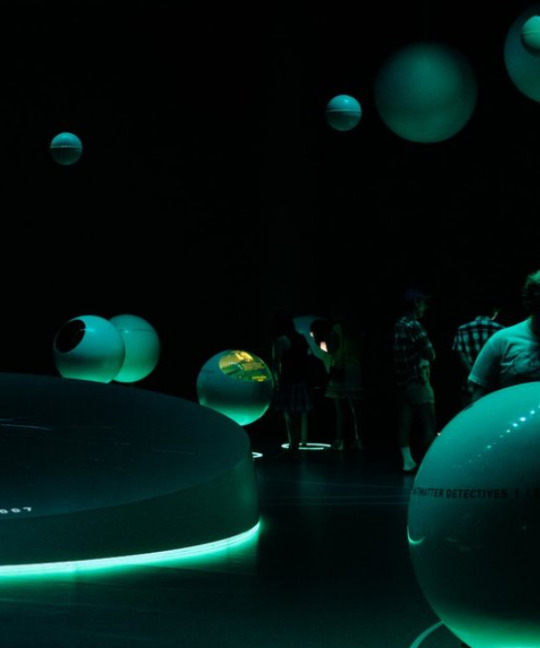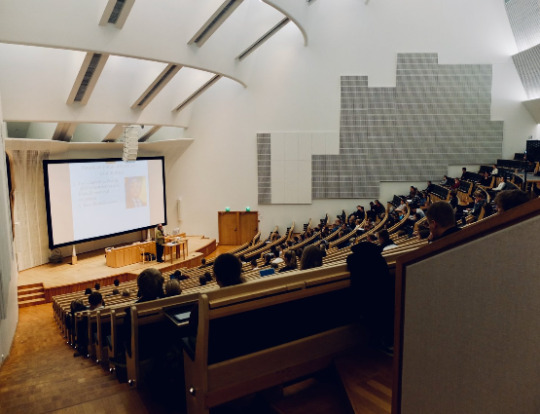#Department of Electrical and Electronics Engineering
Explore tagged Tumblr posts
Text
The Electrical and Electronics Engineering (EEE) department at K.Ramakrishnan College of Engineering (KRCE) has earned a reputation for its outstanding performance in academics and beyond.
#best college of engineering in trichy#best autonomous college of engineering in trichy#krce the top engineering college in trichy#top college of engineering in trichy#Electrical and Electronics Engineering#Department of Electrical and Electronics Engineering#Electrical and Electronics Engineering at Krce
0 notes
Text
More durable metals for fusion power reactors
New Post has been published on https://thedigitalinsider.com/more-durable-metals-for-fusion-power-reactors/
More durable metals for fusion power reactors


For many decades, nuclear fusion power has been viewed as the ultimate energy source. A fusion power plant could generate carbon-free energy at a scale needed to address climate change. And it could be fueled by deuterium recovered from an essentially endless source — seawater.
Decades of work and billions of dollars in research funding have yielded many advances, but challenges remain. To Ju Li, the TEPCO Professor in Nuclear Science and Engineering and a professor of materials science and engineering at MIT, there are still two big challenges. The first is to build a fusion power plant that generates more energy than is put into it; in other words, it produces a net output of power. Researchers worldwide are making progress toward meeting that goal.
The second challenge that Li cites sounds straightforward: “How do we get the heat out?” But understanding the problem and finding a solution are both far from obvious.
Research in the MIT Energy Initiative (MITEI) includes development and testing of advanced materials that may help address those challenges, as well as many other challenges of the energy transition. MITEI has multiple corporate members that have been supporting MIT’s efforts to advance technologies required to harness fusion energy.
The problem: An abundance of helium, a destructive force
Key to a fusion reactor is a superheated plasma — an ionized gas — that’s reacting inside a vacuum vessel. As light atoms in the plasma combine to form heavier ones, they release fast neutrons with high kinetic energy that shoot through the surrounding vacuum vessel into a coolant. During this process, those fast neutrons gradually lose their energy by causing radiation damage and generating heat. The heat that’s transferred to the coolant is eventually used to raise steam that drives an electricity-generating turbine.
The problem is finding a material for the vacuum vessel that remains strong enough to keep the reacting plasma and the coolant apart, while allowing the fast neutrons to pass through to the coolant. If one considers only the damage due to neutrons knocking atoms out of position in the metal structure, the vacuum vessel should last a full decade. However, depending on what materials are used in the fabrication of the vacuum vessel, some projections indicate that the vacuum vessel will last only six to 12 months. Why is that? Today’s nuclear fission reactors also generate neutrons, and those reactors last far longer than a year.
The difference is that fusion neutrons possess much higher kinetic energy than fission neutrons do, and as they penetrate the vacuum vessel walls, some of them interact with the nuclei of atoms in the structural material, giving off particles that rapidly turn into helium atoms. The result is hundreds of times more helium atoms than are present in a fission reactor. Those helium atoms look for somewhere to land — a place with low “embedding energy,” a measure that indicates how much energy it takes for a helium atom to be absorbed. As Li explains, “The helium atoms like to go to places with low helium embedding energy.” And in the metals used in fusion vacuum vessels, there are places with relatively low helium embedding energy — namely, naturally occurring openings called grain boundaries.
Metals are made up of individual grains inside which atoms are lined up in an orderly fashion. Where the grains come together there are gaps where the atoms don’t line up as well. That open space has relatively low helium embedding energy, so the helium atoms congregate there. Worse still, helium atoms have a repellent interaction with other atoms, so the helium atoms basically push open the grain boundary. Over time, the opening grows into a continuous crack, and the vacuum vessel breaks.
That congregation of helium atoms explains why the structure fails much sooner than expected based just on the number of helium atoms that are present. Li offers an analogy to illustrate. “Babylon is a city of a million people. But the claim is that 100 bad persons can destroy the whole city — if all those bad persons work at the city hall.” The solution? Give those bad persons other, more attractive places to go, ideally in their own villages.
To Li, the problem and possible solution are the same in a fusion reactor. If many helium atoms go to the grain boundary at once, they can destroy the metal wall. The solution? Add a small amount of a material that has a helium embedding energy even lower than that of the grain boundary. And over the past two years, Li and his team have demonstrated — both theoretically and experimentally — that their diversionary tactic works. By adding nanoscale particles of a carefully selected second material to the metal wall, they’ve found they can keep the helium atoms that form from congregating in the structurally vulnerable grain boundaries in the metal.
Looking for helium-absorbing compounds
To test their idea, So Yeon Kim ScD ’23 of the Department of Materials Science and Engineering and Haowei Xu PhD ’23 of the Department of Nuclear Science and Engineering acquired a sample composed of two materials, or “phases,” one with a lower helium embedding energy than the other. They and their collaborators then implanted helium ions into the sample at a temperature similar to that in a fusion reactor and watched as bubbles of helium formed. Transmission electron microscope images confirmed that the helium bubbles occurred predominantly in the phase with the lower helium embedding energy. As Li notes, “All the damage is in that phase — evidence that it protected the phase with the higher embedding energy.”
Having confirmed their approach, the researchers were ready to search for helium-absorbing compounds that would work well with iron, which is often the principal metal in vacuum vessel walls. “But calculating helium embedding energy for all sorts of different materials would be computationally demanding and expensive,” says Kim. “We wanted to find a metric that is easy to compute and a reliable indicator of helium embedding energy.”
They found such a metric: the “atomic-scale free volume,” which is basically the maximum size of the internal vacant space available for helium atoms to potentially settle. “This is just the radius of the largest sphere that can fit into a given crystal structure,” explains Kim. “It is a simple calculation.” Examination of a series of possible helium-absorbing ceramic materials confirmed that atomic free volume correlates well with helium embedding energy. Moreover, many of the ceramics they investigated have higher free volume, thus lower embedding energy, than the grain boundaries do.
However, in order to identify options for the nuclear fusion application, the screening needed to include some other factors. For example, in addition to the atomic free volume, a good second phase must be mechanically robust (able to sustain a load); it must not get very radioactive with neutron exposure; and it must be compatible — but not too cozy — with the surrounding metal, so it disperses well but does not dissolve into the metal. “We want to disperse the ceramic phase uniformly in the bulk metal to ensure that all grain boundary regions are close to the dispersed ceramic phase so it can provide protection to those regions,” says Li. “The two phases need to coexist, so the ceramic won’t either clump together or totally dissolve in the iron.”
Using their analytical tools, Kim and Xu examined about 50,000 compounds and identified 750 potential candidates. Of those, a good option for inclusion in a vacuum vessel wall made mainly of iron was iron silicate.
Experimental testing
The researchers were ready to examine samples in the lab. To make the composite material for proof-of-concept demonstrations, Kim and collaborators dispersed nanoscale particles of iron silicate into iron and implanted helium into that composite material. She took X-ray diffraction (XRD) images before and after implanting the helium and also computed the XRD patterns. The ratio between the implanted helium and the dispersed iron silicate was carefully controlled to allow a direct comparison between the experimental and computed XRD patterns. The measured XRD intensity changed with the helium implantation exactly as the calculations had predicted. “That agreement confirms that atomic helium is being stored within the bulk lattice of the iron silicate,” says Kim.
To follow up, Kim directly counted the number of helium bubbles in the composite. In iron samples without the iron silicate added, grain boundaries were flanked by many helium bubbles. In contrast, in the iron samples with the iron silicate ceramic phase added, helium bubbles were spread throughout the material, with many fewer occurring along the grain boundaries. Thus, the iron silicate had provided sites with low helium-embedding energy that lured the helium atoms away from the grain boundaries, protecting those vulnerable openings and preventing cracks from opening up and causing the vacuum vessel to fail catastrophically.
The researchers conclude that adding just 1 percent (by volume) of iron silicate to the iron walls of the vacuum vessel will cut the number of helium bubbles in half and also reduce their diameter by 20 percent — “and having a lot of small bubbles is OK if they’re not in the grain boundaries,” explains Li.
Next steps
Thus far, Li and his team have gone from computational studies of the problem and a possible solution to experimental demonstrations that confirm their approach. And they’re well on their way to commercial fabrication of components. “We’ve made powders that are compatible with existing commercial 3D printers and are preloaded with helium-absorbing ceramics,” say Li. The helium-absorbing nanoparticles are well dispersed and should provide sufficient helium uptake to protect the vulnerable grain boundaries in the structural metals of the vessel walls. While Li confirms that there’s more scientific and engineering work to be done, he, along with Alexander O’Brien PhD ’23 of the Department of Nuclear Science and Engineering and Kang Pyo So, a former postdoc in the same department, have already developed a startup company that’s ready to 3D print structural materials that can meet all the challenges faced by the vacuum vessel inside a fusion reactor.
This research was supported by Eni S.p.A. through the MIT Energy Initiative. Additional support was provided by a Kwajeong Scholarship; the U.S. Department of Energy (DOE) Laboratory Directed Research and Development program at Idaho National Laboratory; U.S. DOE Lawrence Livermore National Laboratory; and Creative Materials Discovery Program through the National Research Foundation of Korea.
#000#3d#3D printers#ADD#advanced materials#agreement#approach#atom#atomic#atoms#bubbles#carbon#ceramics#challenge#change#climate#climate change#comparison#continuous#crystal#crystal structure#Department of Energy (DoE)#development#DMSE#easy#electricity#electron#energy#engineering#experimental
0 notes
Text
Kevin vs. Quantum Mechanics
This is an autobiographical piece. Names have been changed for anonymity, but it's otherwise left be. ---
The class's first suspicion of Kevin was that he had, somehow, cheated his way up to this course. He just seemed perpetually confused, and strangely antagonistic of the professor. The weirdest example of this was when he asked what an ion was (in a third year EE class?), and was informed that it referred to any positively or negatively charged particle. It would have been strange enough to ask, but his reply of "Either? That doesn't sound right" sealed him in as a well known character in the class of 19 people.
The real tipping point in our perception of him during a lecture where the professor mentioned practical uses for a neutron beam, and Kevin asked if a beam could be made out of some other neutral material. When asked "Like what?", he replied "An atom with all of its electrons removed." When we pointed out that the protons would make that abomination extremely positively charged, he just replied with "So what if we removed those too?" and then was baffled when we informed him that would just be neutrons.
That's high school level chemistry. Not knowing it was so incredibly strange that I felt like something was off, so I asked him if he'd like to grab lunch. He accepted, we chatted, and I finally began to get a sense of his origin story.
See, Kevin wasn't a junior/senior electrical engineer like the rest of us. Kevin was, in fact, three notable things: A business major, a sophomore, and a hardcore Catholic. All three of those are essential to understanding his scenario.
What had begun all of this was actually a conflict with Kevin and his roommate. Kevin frequently had his fundamental belief in Absolute Good, Absolute Bad, and Absolute Anything pushed back on by his roommate, who was in STEM. Said roommate kept invoking quantum mechanics as his proof against Absolute Knowledge. Kevin was tired of having something that he didn't understand thrown at his convictions, so he decided to take a quantum course to settle things once and for all.
Despite not having any of the pre-reqs.
He'd actually tried to take quantum for physicists first, but the school's physics department wouldn't let him. It's actually pretty strictly regulated, because it is a mandatory class for physics majors. However, because quantum is not mandatory for electrical engineers, there aren't really any built in requirements for the class. It's just assumed that nobody would actually try to take it until their third year because doing so would the be the mental equivalent to slamming your nuts in the car door. Just, pure suffering for no good reason.
Apparently, the counselors had tried to talk him out of it, but if Kevin was one thing, it was stubborn. He'd actually had to sign some papers basically saying "I was warned that this is incredibly stupid, but I refused to listen" in order to take the class.
He was actually pretty nice, if currently unaware of how bad he'd just fucked up. I paid for the lunch, wished him the best, and reported back to the class discord. We'd all been curious about this guy's story, but now that I had the truth, I could share it with the world.
Feelings were mixed. Some people thought he was going to drop out any minute now. Others thought that he wouldn't, be also that convincing him to drop now, while he still could, was the only ethical thing. Others figured that a policy of non-interference was best: The counselors couldn't dissuade him, and if we tried to do the same, he'd probably just think it was STEM elitism trying to guard its little clubhouse. He'd figure out how hard things were, or he'd fail. Either way, it would help him learn more about the world.
We wound up taking the approach of non-interference. If nothing else, understanding his origins gave us more patience when he asked bizarre questions. He wasn't trying to waste our time, he was just trying to cram three years of pre-reqs into a one semester course. He did get a little bit combative sometimes, and we could tell that he was really wracking his brain to try and find some sort of contradiction or error that he could use to bring the whole thing down, but he never could.
First test came by, and he bombed it. Completely unprepared. He'd taken Calc I, but he didn't know how to do integrals yet (that was Calc II). Worse, he was far past the drop date. I imagine most people in his shoes would've stopped struggling. They'd realize they were fucked and just let themselves fail, at least salvaging their other classes grades in the process. Why waste resources on an unwinnable battle?
Kevin never asked questions like that. If he was stupid enough to try it, he was stupid enough to finish it. God bless him.
He invited me to lunch after the test and said that the class was more fascinating than he'd ever imagined, but he didn't know if he'd be able to pass it. He asked if I could help, and I said...maybe. I brought the request to the discord, and from the eight people there I got three volunteers who admired this dork's tenacity. He was in over his head, miles beneath the surface, but his fighting spirit was fucking glorious. If he was willing to go down swinging, we were willing to bust our asses trying to get him caught up.
Some of the stuff was just extra homework we gave to the guy. We told him he needed to learn integrals, stat. We sent him some copies of basic software that can be used to teach the basics of linear circuit equations, and he practiced that game like it was HALO. Just, hours sunk into it. Absolutely godlike.
He was still scrabbling for air at just the surface level of the class, but he'd gone from abysmal failure to lingering on the boundary between life and death. Other people in the class started to learn about Kevin's origin story, and our little circle of four volunteer tutors grew to six. Every day, he had someone trying to help him either catch up in some way, or finish that week's homework. He'd gone from being seen as a nuisance that wasted class time to the underdog mascot.
He was getting twelve hours of personal tutoring a week, on top of three hours of classes, on top of six hours of office hours, on top of the coursework. I don't think it's an exaggeration to say that this kid was doing 40 hours a week just trying to pass this one single class.
Second test comes around and he gets a 60. He's ecstatic. We're ecstatic. Kid's too young to take out drinking so we just order a pizza and cheer like he just won gold at the Olympics.
After that second test, things hit another tipping point. With so much catch-up under his belt, he was able to focus a lot more on the actual material for the class. A borderline cinematic moment happened when I was trying to get ahead on the homework so that I could put more hours in on my senior project. Nobody else had finished it yet because it wasn't due for another week, so the specifics of the problem I was working on were still a mystery. I went to the professor's office hours and get some pointers, but he wasn't willing to give good hints when the HW wasn't due for another week or so. He said I still had time to think about it, which was true, but I wanted to be able to think about other things. Kevin had watched the whole conversation, waiting for his turn to ask the professor more simple questions, but when I left I got a text from him telling me to hop on zoom.
Kevin had finished it earlier, because Kevin started all of his homework the moment it was assigned. He needed to, in order to make sure that he could get it done on time. He'd finished it the day before, and was able to walk me through it.
From student, to teacher. I'm not exaggerating when I say that he probably saved me eight hours on that assignment. I could've kissed him.
A month or two later, we took the final. As soon as we were done, we six asked Kevin how he did. He was nervous, there was so much new material for him in this class that his retention hadn't been great. Us six were also a little stressed: We were going to pass the class, but the final was hard.
We waited for the results.
And waited. And waited.
Finally, the scores were posted as a table, curve included. From our class of 19 people, 4 withdrew within the deadline, 4 failed, 1 got a C, 8 got B's, and 2 got A's. We could see that the curve for a C was set at 59.2% overall.
We called Kevin. He was crying. End score, 59.2%. Teacher curved the C exactly to his score.
It was a week into winter break so we couldn't gather the forces around for a party like last time, but we were all losing our shit. Kevin was losing his shit. He couldn't believe how stupid he was to try this course, he couldn't believe that six people busted their ass just to make sure he didn't die, and he couldn't believe that the professor basically just passed him out of sheer effort alone.
He said it was the stupidest thing he'd ever done, and while I doubt that, it was outrageously stupid. And yet, I've never been so invested in a fellow student before. I'm prouder of Kevin's C than I am of my own B. I was walking on sunshine for weeks after that. In theory, my senior project was building a functioning washing machine, but in practice, in my heart, it was helping Kevin pass Intro to Quantum for Electrical Engineers.
(And as an epilogue: No, he did not renounce Catholicism and become an atheist like his roommate had hoped. He did walk out changed. I think that being that wrong about something, and realizing it, was a pivotal moment for him. It's hard to be dogmatic once you realize that a lifetime of being wrong feels exactly like a lifetime of being right, right up until the last two seconds of it.)
#writing#Kevin#electrical engineering#college#memoir#biography#college stories#group project#quantum physics#senior project#people are awesome#Babylon-Lore#Babylon-TopPick
3K notes
·
View notes
Text
A prominent computer scientist who has spent 20 years publishing academic papers on cryptography, privacy, and cybersecurity has gone incommunicado, had his professor profile, email account, and phone number removed by his employer, Indiana University, and had his homes raided by the FBI. No one knows why.
Xiaofeng Wang has a long list of prestigious titles. He was the associate dean for research at Indiana University's Luddy School of Informatics, Computing and Engineering, a fellow at the Institute of Electrical and Electronics Engineers and the American Association for the Advancement of Science, and a tenured professor at Indiana University at Bloomington. According to his employer, he has served as principal investigator on research projects totaling nearly $23 million over his 21 years there.
He has also coauthored scores of academic papers on a diverse range of research fields, including cryptography, systems security, and data privacy, including the protection of human genomic data. I have personally spoken to him on three occasions for articles here, here, and here.
“None of This Is in Any Way Normal”
In recent weeks, Wang's email account, phone number, and profile page at the Luddy School were quietly erased by his employer. Over the same time, Indiana University also removed a profile for his wife, Nianli Ma, who was listed as a lead systems analyst and programmer at the university's Library Technologies division.
As reported by The Bloomingtonian and later the The Herald-Times in Bloomington, a small fleet of unmarked cars driven by government agents descended on the Bloomington home of Wang and Ma on Friday. They spent most of the day going in and out of the house and occasionally transferred boxes from their vehicles. TV station WTHR, meanwhile, reported that a second home owned by Wang and Ma, located in Carmel, Indiana, was also searched. The station said that both a resident and an attorney for the resident were on scene during at least part of the search.
Attempts to locate Wang and Ma have so far been unsuccessful. An Indiana University spokesman didn't answer emailed questions asking if the couple was still employed by the university and why their profile pages, email addresses, and phone numbers had been removed. The spokesman provided the contact information for a spokeswoman at the FBI's field office in Indianapolis. In an email, the spokeswoman wrote: “The FBI conducted court authorized law enforcement activity at homes in Bloomington and Carmel Friday. We have no further comment at this time.”
Searches of federal court dockets turned up no documents related to Wang, Ma, or any searches of their residences. The FBI spokeswoman didn't answer questions seeking which US district court issued the warrant and when, and whether either Wang or Ma is being detained by authorities. Justice Department representatives didn't return an email seeking the same information. An email sent to a personal email address belonging to Wang went unanswered at the time this post went live. Their resident status (e.g., US citizens or green card holders) is currently unknown.
Fellow researchers took to social media over the weekend to register their concern over the series of events.
“None of this is in any way normal,” Matthew Green, a professor specializing in cryptography at Johns Hopkins University, wrote on Mastodon. He continued: “Has anyone been in contact? I hear he’s been missing for two weeks and his students can’t reach him. How does this not get noticed for two weeks???”
In the same thread, Matt Blaze, a McDevitt professor of computer science and law at Georgetown University, said, “It's hard to imagine what reason there could be for the university to scrub its website as if he never worked there. And while there's a process for removing tenured faculty, it takes more than an afternoon to do it.”
Local news outlets reported the agents spent several hours moving boxes in an out of the residences. WTHR provided the following details about the raid on the Carmel home:
Neighbors say the agents announced "FBI, come out!" over a megaphone.
A woman came out of the house holding a phone. A video from a neighbor shows an agent taking that phone from her. She was then questioned in the driveway before agents began searching the home, collecting evidence and taking photos.
A car was pulled out of the garage slightly to allow investigators to access the attic.
The woman left the house before 13News arrived. She returned just after noon accompanied by a lawyer. The group of 10 or so investigators left a few minutes later.
The FBI would not say what they were looking for or who is under investigation. A bureau spokesperson issued a statement: “I can confirm we conducted court-authorized activity at the address in Carmel today. We have no further comment at this time.”
Investigators were at the house for about four hours before leaving with several boxes of evidence. 13News rang the doorbell when the agents were gone. A lawyer representing the family who answered the door told us they're not sure yet what the investigation is about.
This post will be updated if new details become available. Anyone with firsthand knowledge of events involving Wang, Ma, or the investigation into either is encouraged to contact me, preferably over Signal at DanArs.82. The email address is: [email protected].
34 notes
·
View notes
Text

U.S. Approves Foreign Military Sale for South Korean F-15K Upgrade
The State Department has approved the possible sale of components that will allow South Korea to upgrade its F-15K Slam Eagle fleet to a configuration similar to the F-15EX Eagle II.
Stefano D'Urso
F-15K upgrade
The U.S. State Department has approved on Nov.19, 2024, a possible Foreign Military Sale (FMS) to the Republic of Korea of components that will allow the upgrade of the country’s F-15K Slam Eagle fleet. The package, which has an estimated cost of $6.2 billion, follows the decision in 2022 to launch an upgrade program for the aircraft.
The State Department has approved the possible sale of components that will allow South Korea to upgrade its F-15K Slam Eagle fleet to a configuration similar to the F-15EX Eagle II.The F-15KThe new capabilities
The Slam Eagles are the mainstay of the Republic of Korea Air Force’s (ROKAF) multirole missions, with a particular ‘heavy hitting’ long-range strike role. According to the available data, the country operates 59 F-15Ks out of 61 which were initially fielded in 2005. In 2022, the Defense Acquisition Program Administration (DAPA) approved the launch of an upgrade program planned to run from 2024 to 2034.
In particular, the Defense Security Cooperation Agency’s (DSCA) FMS notice says a number of components were requested for the upgrade, including 96 Advanced Display Core Processor II (ADCP II) mission system computers, 70 AN/APG-82(v)1 Active Electronically Scanned Arrays (AESA) radars, seventy 70 AN/ALQ-250 Eagle Passive Active Warning Survivability System (EPAWSS) electronic warfare (EW) suites and 70 AN/AAR-57 Common Missile Warning Systems (CMWS).
In addition to these, South Korea will also get modifications and maintenance support, aircraft components and spares, consumables, training aids and the entire support package commonly associated with FMS. It is interesting to note that the notice also includes aerial refueling support and aircraft ferry support, so it is possible that at least the initial aircraft will be ferried to the United States for the modifications before the rest are modified in country.

A ROKAF F-15K Slam Eagle drops two GBU-31 JDAM bombs with BLU-109 warhead. (Image credit: ROKAF)
The components included in the possible sale will allow the ROKAF to upgrade its entire fleet of F-15Ks to a configuration similar to the new F-15EX Eagle II currently being delivered to the U.S. Air Force. Interestingly, the Korean configuration will also include the CMWS, currently not installed on the EX, so the F-15K will also require some structural modifications to add the blisters on each side of the canopy rail where the sensors are installed.
“This proposed sale will improve the Republic of Korea’s capability to meet current and future threats by increasing its critical air defence capability to deter aggression in the region and to ensure interoperability with US forces,” says the DSCA in the official notice.
The upgrade of the F-15K is part of a broader modernization of the ROKAF’s fighter fleet. In fact, the service is also upgrading its KF-16s Block 52 to the V configuration, integrating a new AESA radar, mission computer, self-protection suite, with works expected to be completed by 2025. These programs complement the acquisition of the F-35 Lightning II and the KF-21 Boramae.
Ulchi Freedom Shield 24

A ROKAF F-15K Slam Eagle, assigned to the 11th Fighter Wing at Daegu Air Base, takes off for a mission on Aug. 20, 2024. (Image credit: ROKAF)
The F-15K
The F-15K is a variant of the F-15E Strike Eagle built for the Republic of Korea Air Force’s (ROKAF) with almost half of the components manufactured locally. The aircraft emerged as the winner of the F-X fighter program against the Rafale, Typhoon and Su-35 in 2002, resulting in an order for 40 F-15s equipped with General Electric F110-129 engines. In 2005, a second order for 21 aircraft equipped with Pratt & Whitney F100-PW-229 engines was signed.
The Slam Eagle name is derived from the F-15K’s capability to employ the AGM-84H SLAM-ER standoff cruise missiles, with the Taurus KEPD 350K being another weapon exclusive to the ROKAF jet. The F-15K is employed as a fully multi-role aircraft and is considered ad one of the key assets of the Korean armed forces.
With the aircraft averaging an age of 16 years and expected to be in service until 2060, the Defense Acquisition Program Administration (DAPA) launched in 2022 an upgrade program for the F-15Ks. The upgrade, expected to run from 2024 to 2034, is committed to strengthening the mission capabilities and survivability of the jet.
The F-15K currently equips three squadrons at Daegu Air Base, in the southeast of the country. Although based far from the demilitarized zone (DMZ), the F-15K with its SLAM-ER and KEPD 350 missiles can still hit strategic targets deep behind North Korean borders.

An F-15K releases a Taurus KEPD 350K cruise missile. (Image credit: ROKAF)
The new capabilities
It is not yet clear if the F-15K will receive a new cockpit, since its configuration will be similar to the Eagle II. In fact, the F-15EX has a full glass cockpit equipped with a 10×19-inch touch-screen multifunction color display and JHMCS II both in the front and rear cockpit, Low Profile HUD in the front, stand-by display and dedicated engine, fuel and hydraulics display, in addition to the standard caution/warning lights, switches and Hands On Throttle-And-Stick (HOTAS) control.
Either way, the systems will be powered by the Advanced Display Core Processor II, reportedly the fastest mission computer ever installed on a fighter jet, and the Operational Flight Program Suite 9.1X, a customized variant of the Suite 9 used on the F-15C and F-15E, designed to ensure full interoperability of the new aircraft with the “legacy Eagles”.
The F-15K will be equipped with the new AN/APG-82(V)1 Active Electronically Scanned Array (AESA) radar. The radar, which has been developed from the APG-63(V)3 AESA radar of the F-15C and the APG-79 AESA radar of the F/A-18E/F, allows to simultaneously detect, identify and track multiple air and surface targets at longer ranges compared to mechanical radars, facilitating persistent target observation and information sharing for a better decision-making process.
F-15K upgrade

A ROKAF F-15K Slam Eagle takes off for a night mission during the Pitch Black 2024 exercise. (Image credit: Australian Defense Force)
The AN/ALQ-250 EPAWSS will provide full-spectrum EW capabilities, including radar warning, geolocation, situational awareness, and self-protection to the F-15. Chaff and flares capacity will be increased by 50%, with four more dispensers added in the EPAWSS fairings behind the tail fins (two for each fairing), for a total of 12 dispenser housing 360 cartridges.
EPAWSS is fully integrated with radar warning, geo-location and increased chaff and flare capability to detect and defeat surface and airborne threats in signal-dense and highly contested environments. Because of this, the system enables freedom of maneuver and deeper penetration into battlespaces protected by modern integrated air defense systems.
The AN/AAR-57 CMWS is an ultra-violet based missile warning system, part of an integrated IR countermeasures suite utilizing five sensors to display accurate threat location and dispense decoys/countermeasures. Although CMWS was initially fielded in 2005, BAE Systems continuously customized the algorithms to adapt to new threats and CMWS has now reached Generation 3.
@TheAviationist.com
21 notes
·
View notes
Text

Semi-metals offer new possibilities for electronic devices
Dr. Yuxuan Cosmi Lin, assistant professor in the Department of Materials Science and Engineering at Texas A&M University, and a team of researchers are studying the potential applications and unique physical properties of semi-metals in electronic devices. This study was published in Nature Reviews Electrical Engineering. Traditionally, microelectronics and electronic materials can be made of three types of material: semiconductors for computing, metals for transducing power and signals, and insulators to isolate different electrical components. A fourth kind of material, semi-metals, may offer a better alternative than the industry standard. Semi-metals are a special kind of material whose properties are in between metals and semiconductors. These materials are significant due to their favorable properties, such as widely tunable electronic energy states, electrical conductivity, and their unique topological properties, which help control the flow of electronic devices like transistors and microchips.
Read more.
26 notes
·
View notes
Text
Hello loyal players of Real Life™! The physics department from BiNaS is rolling out a new patch tomorrow at 2:00 pm GMT. Here's some things we're changing:
Patched the bug discovered by user Hendrik_Lorentz_187 that caused electromagnetic fields to interact with moving, charged particles.
Nerfed electrical energy by deleting about 0.1% of all electrons randomly every year.
A square meter is now equal to 10 square decimeters instead of 100. The same goes for all square and cube units.
Decreased absolute zero to -20° Kelvin.
Optimised engine by no longer applying superposition to unobserved particles but instead freezing them in place until they are observed again.
Set the origin point of the coördinate system to the center of the earth to fix all the issues caused by the previously mentioned optimisation.
Gravity no longer affects elements smaller than a proton or larger than Jupiter.
Negative charges now attract each other and repulse positive charges, as well as the opposite, to prevent confusion during the high school stage of Real Life™ and its puzzles.
Removed neutrons due to taking up unnecessary space.
Increased the amount of spatial dimensions to 4.
Removed the bug reported by Doppler69 that caused different perceptions of all waves for users that are fast-travelling.
Reduced the amount of elements back to 4.
Redistributed natural disasters fairly across the map.
Buffed radiation back up to its original form when introduced to the games bèta as magic.
Removed wind mechanics as players reported them to be too annoying.
#binas#natuurkunde#physics#physics memes#shitpost#i thought id make an english post for a change#just trying out some things with this blog#prob dont follow me for this bc none of my posts thus far are even remotely like this one
20 notes
·
View notes
Text


Electromagnetic wave phenomenon impacting Earth’s radiation belts
Two University of Alaska Fairbanks scientists have discovered a new type of “whistler,” an electromagnetic wave that carries a substantial amount of lightning energy to the Earth’s magnetosphere.
The research is published today in Science Advances.
Vikas Sonwalkar, a professor emeritus, and Amani Reddy, an assistant professor, discovered the new type of wave. The wave carries lightning energy, which enters the ionosphere at low latitudes, to the magnetosphere. The energy is reflected upward by the ionosphere’s lower boundary, at about 55 miles altitude, in the opposite hemisphere.
It was previously believed, the authors write, that lightning energy entering the ionosphere at low latitudes remained trapped in the ionosphere and therefore was not reaching the radiation belts. The belts are two layers of charged particles surrounding the planet and held in place by Earth's magnetic field.
“We as a society are dependent on space technology,” Sonwalkar said. “Modern communication and navigation systems, satellites, and spacecraft with astronauts aboard encounter harmful energetic particles of the radiation belts, which can damage electronics and cause cancer.
“Having a better understanding of radiation belts and the variety of electromagnetic waves, including those originating in terrestrial lightning, that impact them is vital for human operations in space,” he said.
Sonwalkar and Reddy’s discovery is a type of whistler wave they call a “specularly reflected whistler.” Whistlers produce a whistling sound when played through a speaker.
Lightning energy entering the ionosphere at higher latitudes reaches the magnetosphere as a different type of whistler called a magnetospherically reflected whistler, which undergoes one or more reflections within the magnetosphere.
The ionosphere is a layer of Earth's upper atmosphere characterized by a high concentration of ions and free electrons. It is ionized by solar radiation and cosmic rays, making it conductive and crucial for radio communication because it reflects and modifies radio waves.
Earth's magnetosphere is a region of space surrounding the planet and created by Earth's magnetic field. It provides a protective barrier that prevents most of the solar wind's particles from reaching the atmosphere and harming life and technology.
Sonwalkar and Reddy’s research shows that both types of whistlers — specularly reflected whistlers and magnetospherically reflected whistlers — coexist in the magnetosphere.
In their research, the authors used plasma wave data from NASA’s Van Allen Probes, which launched in 2012 and operated until 2019, and lightning data from the World Wide Lightning Detection Network.
They developed a wave propagation model that, when considering specularly reflected whistlers, showed the doubling of lightning energy reaching the magnetosphere.
Review of plasma wave data from the Van Allen Probes showed that specularly reflected whistlers are a common magnetospheric phenomenon.
A majority of lightning occurs at the low latitudes, which are tropical and subtropical regions prone to thunderstorm development.
“This implies that specularly reflected whistlers probably carry a greater part of lightning energy to the magnetosphere relative to that carried by magnetospherically reflected whistlers,” Sonwalkar said.
The impact of lightning-generated whistler waves on radiation belt physics and their use in remote sensing of magnetospheric plasma have been researched since the 1950s.
Sonwalkar and Reddy are with the Department of Electrical and Computer Engineering in the UAF College of Engineering and Mines. Reddy is also affiliated with the UAF Geophysical Institute.
Sonwalkar and Reddy’s research is supported by grants from the National Science Foundation and NASA EPSCoR, the Established Program to Stimulate Competitive Research.
13 notes
·
View notes
Text
The Setting
Bougainville


A quaint town with a population of 10,000. Located in the Pas-de-Calais department of Northern France, it is an amalgamation of days past and modern times; preserving its original construction from 150 years ago while intertwining with modern-day advancements.
History


The town was founded in the late 1800s by Olivier Bougainvillea: a renowned physicist from Paris who led a scientific expedition to the area that would later be known as Bougainville. The goal of his expedition was to study unusual electromagnetic radiations within the area. He set up a research base that would inadvertently grow with the influx of scientists and researchers Bougainvillea recruited to participate in his research. The growing scale of Bougainvillea's research necessitated better infrastructure and living facilities; resulting in the arrival of more labor for construction. The rapid influx of people now requiring long-term accommodation in the area demanded more housing, and soon the base had transformed into a small hamlet. Thus, began the settlement of Bougainville. As time passed, the families of the workers and researchers had relocated to the area; operating independent businesses to fill demands such as clothing, food, and other essential supplies. And as the economy grew, so did the settlement. More merchants and businesses settled in the hamlet, and soon, what was once a research base became the town of Bougainville: named after the lead scientist that pioneered the settlement of the area and powered the town with his discoveries and innovations. In honour of his legacy, Bougainvillea flowers line the front of almost every street, creating a beautiful sight at every turn.
Geography

Bougainville has Calais to the north, Le Portel to the west, Lumbres to the east, and Desvres to the south. It is nestled adjacent to the Parc naturel regional des caps et marais d’Opale. As such, lazily drifting fog and chilly weather are a permanent fixture in the small town, perfectly complementing its slow, leisurely lifestyle. A river divides the town into two sides: West and East. Western Bougainville is its central business district; housing the entertainment district and the shopping district; as well as the town hall, Bougainville bank, and police station. Eastern Bougainville is the town’s health and education district; being the location of Bougainvillea University, Bougainville General Hospital, and the Bougainvillea Foundation’s central laboratory; which is open to the public as a science museum. To the north of the town is the Emilie Francoise Nature Reserve, which is 1000 acres of protected marshland and forest. It is also here that the Bougainvillea Power Plant is located; which provides electricity to the entire town.
The Bougainvillea Foundation

A multinational conglomerate with subsidiaries in a variety of industries.
Including, but not limited to:
pharmaceuticals
medical equipment
electronics
non-profit organizations
military equipment
firearms.
Central Laboratory

One of the crowning jewels of Bougainville, the Bougainvillea central laboratory is a marvel of modern engineering. From its humble beginnings as a research tent, it is now the primary location for all of the Bougainvillea Foundation’s science exhibitions. Thus, it is a famous field trip destination for many educational institutes. It is the oldest and largest lab of the Bougainvillea Foundation. It has contributed much to the lifestyle advancements in Bougainville by: supplying power; being the primary supplier of medicine, medical supplies, and funds the Bougainville healthcare system; and founding Bougainvillea University.



Bougainvillea University

Founded in the honor of Olivier Bougainvillea for his contributions to modern science and the founding of Bougainville, Bougainvillea University strives to shape brilliant minds that will pave the way to innovation and discovery. Graduates of this university may receive highly coveted employment with the Bougainvillea Foundation.




Bougainville General Hospital

From its humble beginnings as a small 3-bed health clinic, the facility has grown to an impressive 300-bed general hospital with an emergency department and specialist operating theatres. Though it has maintained its original exterior, its interior has been refurbished with state-of-the-art healthcare facilities thanks to the generous donations of the Bougainvillea Foundation.
Shopping District

The location of most of the shops in Bougainville. It is the most popular tourist and student destination in town, boasting an array of grocers, book stores, bakeries, boutiques, cafes, restaurants, and wineries.




Entertainment District

The centre of Bougainville’s nightlife, this area is where most of Bougainville’s adult recreational businesses are located. From bars, taverns, and billiard, to nightclubs, strip clubs and gambling.
Emilie Francoise Nature Reserve

Named after the town founder’s wife and fellow scientist, Emilie Francoise nature reserve is 1000 acres of protected marshland and forest. The reserve is a popular hiking and camping destination for locals and visitors alike. In honor of Olivier Bougainvillea's beloved wife, fellow scientist, and Parisian ecologist, the nature reserve aims to continue the conservation efforts of Emilie Francoise Bougainvillea in protecting the town’s natural landscape.
Key Locations

Luna Lake A crystalline lake that is 30 km wide that reflects the sky like a mirror. At night time, it seems to hold the moon on its surface. It is populated by diverse aquatic life, making it a popular fishing spot.

Bellevue Valley A valley covered with flowers all year long. Different flowers bloom during different seasons and months.

Celine Falls The biggest, most scenic water fall in the nature reserve

Labyrinthe Marshland The largest marshland in the nature reserve and home to a diverse population of wildlife.
The Underground

There are whispers of an underground black market where illicit goods and services are distributed. Though its location is largely unknown…
▶ Wildward Master Post
70 notes
·
View notes
Text
Why are so many cars designed to make it almost impossible to replace the headlight bulbs? Even LEDs do not last forever.
The difficult headlight bulb replacement in modern cars stems from several deliberate design trade-offs – prioritizing other factors over serviceability. Here's why engineers often sacrifice accessibility:
Aerodynamics & Styling Demands:
Low, Sloping Hoods: Aggressive aerodynamic profiles minimize the space under the hood, pushing components (including the headlight assemblies) closer to the radiator, engine, and structural elements.
Seamless Body Lines: Sleek headlight designs with complex contours often require integrated bezels and trim pieces that physically block access points. Removing bumpers or entire assemblies becomes necessary to preserve the desired visual lines.
Thin Headlight Profiles: Modern lights are shallow and wrap tightly around body panels, leaving minimal clearance behind the bulb socket.
Overcrowded Engine Bays:
Packing in Tech: Modern engine compartments are packed with turbochargers, intercoolers, complex intake systems, emission control devices, coolant reservoirs, air ducts, battery boxes, fuseboxes, and wiring harnesses.
Prioritized Placement: Engineers give prime, accessible space to critical components like the air filter, oil dipstick, coolant reservoir, and brake fluid. Headlight bulbs become an afterthought, relegated to the cramped spaces left behind.
Complex Headlight Assemblies (Especially for LEDs):
Sealed Units: Most modern LED headlights are not designed with replaceable "bulbs" like halogens. The LEDs are tiny chips soldered onto circuit boards, integrated with heatsinks, lenses, projectors, and complex electronic drivers.
Thermal Management: LED units require effective heat dissipation, often involving large heatsinks and fans inside the sealed assembly. Making them easily serviceable would compromise the thermal seal and design integrity. They are designed as a single, sealed module.
Alignment & Calibration: Modern adaptive headlights (swiveling cornering beams, auto-leveling) require extremely precise optical alignment and electronic calibration from the factory. Replacing an internal LED chip would likely disrupt this precision far more than swapping a simple halogen bulb. Replacing the whole sealed unit ensures this calibration remains intact (it's locked into the housing).
Moisture Seal: Creating a user-serviceable opening for LED chips without compromising the hermetic seal against moisture (which would rapidly destroy the electronics) is extremely difficult.
Safety and Regulatory Concerns:
Accurate Beam Pattern: Headlights must be perfectly aligned to avoid blinding oncoming traffic. A complex mounting system helps ensure the entire headlight assembly remains stable and doesn't get knocked out of alignment easily. Making bulbs "toolless" might compromise this stability.
Electrical Integrity: Complex connectors and wiring harnesses are designed for reliability over the life of the vehicle, not for frequent disconnection/reconnection by owners. Easier access might increase the risk of moisture ingress or connector damage.
Manufacturing Cost, Efficiency & Profit:
Simplified Assembly Line: Designing for easy post-assembly service adds complexity during manufacturing. Mounting the headlight assembly deep within the front end might be faster/easier on the line than leaving room for hand access later.
Dealer Service Profit: While often overstated as the primary reason, manufacturers know difficult repairs increase the likelihood owners will use dealer service departments, where labor rates are high. Making bulbs easy to swap yourself costs them potential revenue.
Reduced Parts Inventory: Designing around sealed LED modules reduces the number of individual parts needed (bulb types, sockets) and simplifies inventory logistics, even though the module itself is more expensive.
Longevity Focus (Even with LEDs):
Perceived Permanence: While LEDs don't last forever, their projected lifespan (often 10,000-15,000 hours+) significantly exceeds the average ownership period of a vehicle (around 8 years). Manufacturers design knowing that most owners won't need to replace them during their ownership, reducing the incentive to prioritize access.
Electronics vs. Filament: Halogen bulbs fail frequently due to fragile filaments. LED modules are solid-state electronics. While the LEDs themselves are long-lasting, drivers/fans/corrosion can cause the entire module to fail before the individual LEDs burn out. It's simpler/necessary to replace the complex module rather than diagnose and repair individual electronic components embedded within it.
In Summary: Engineers are solving a complex puzzle: maximizing aerodynamics, fitting more technology, meeting strict safety regulations, achieving aggressive styling, managing thermal loads (LEDs), ensuring long-term reliability/sealing, and minimizing manufacturing costs/ease. Prioritizing your ability to quickly replace a bulb is rarely high on that list, especially with LEDs designed as long-life, sealed units for performance and reliability reasons. While frustrating for DIY mechanics, the trade-offs made sense to the designers for the other priorities.

#led lights#car lights#led car light#youtube#led auto light#led headlights#led light#led headlight bulbs#ledlighting#young artist#led light bulbs#led strip lights#car rental#cars#electric cars#classic cars#car#carlos sainz#truck#porsche#sabrina carpenter#suv#lamborghini#bmw#autonomous vehicle headlights#overtake another vehicle#older vehicles#very pretty#vehicle#automatic headlights
2 notes
·
View notes
Text
#best college of engineering in trichy#best autonomous college of engineering in trichy#krce the top engineering college in trichy#krce the best college of engineering in trichy#Electrical and Electronics Engineering#Department of Electrical and Electronics Engineering#krce at Electrical and Electronics Engineering
0 notes
Text
Turning up the heat on next-generation semiconductors
New Post has been published on https://thedigitalinsider.com/turning-up-the-heat-on-next-generation-semiconductors/
Turning up the heat on next-generation semiconductors


The scorching surface of Venus, where temperatures can climb to 480 degrees Celsius (hot enough to melt lead), is an inhospitable place for humans and machines alike. One reason scientists have not yet been able to send a rover to the planet’s surface is because silicon-based electronics can’t operate in such extreme temperatures for an extended period of time.
For high-temperature applications like Venus exploration, researchers have recently turned to gallium nitride, a unique material that can withstand temperatures of 500 degrees or more.
The material is already used in some terrestrial electronics, like phone chargers and cell phone towers, but scientists don’t have a good grasp of how gallium nitride devices would behave at temperatures beyond 300 degrees, which is the operational limit of conventional silicon electronics.
In a new paper published in Applied Physics Letters, which is part of a multiyear research effort, a team of scientists from MIT and elsewhere sought to answer key questions about the material’s properties and performance at extremely high temperatures.
They studied the impact of temperature on the ohmic contacts in a gallium nitride device. Ohmic contacts are key components that connect a semiconductor device with the outside world.
The researchers found that extreme temperatures didn’t cause significant degradation to the gallium nitride material or contacts. They were surprised to see that the contacts remained structurally intact even when held at 500 degrees Celsius for 48 hours.
Understanding how contacts perform at extreme temperatures is an important step toward the group’s next goal of developing high-performance transistors that could operate on the surface of Venus. Such transistors could also be used on Earth in electronics for applications like extracting geothermal energy or monitoring the inside of jet engines.
“Transistors are the heart of most modern electronics, but we didn’t want to jump straight to making a gallium nitride transistor because so much could go wrong. We first wanted to make sure the material and contacts could survive, and figure out how much they change as you increase the temperature. We’ll design our transistor from these basic material building blocks,” says John Niroula, an electrical engineering and computer science (EECS) graduate student and lead author of the paper.
His co-authors include Qingyun Xie PhD ’24; Mengyang Yuan PhD ’22; EECS graduate students Patrick K. Darmawi-Iskandar and Pradyot Yadav; Gillian K. Micale, a graduate student in the Department of Materials Science and Engineering; senior author Tomás Palacios, the Clarence J. LeBel Professor of EECS, director of the Microsystems Technology Laboratories, and a member of the Research Laboratory of Electronics; as well as collaborators Nitul S. Rajput of the Technology Innovation Institute of the United Arab Emirates; Siddharth Rajan of Ohio State University; Yuji Zhao of Rice University; and Nadim Chowdhury of Bangladesh University of Engineering and Technology.
Turning up the heat
While gallium nitride has recently attracted much attention, the material is still decades behind silicon when it comes to scientists’ understanding of how its properties change under different conditions. One such property is resistance, the flow of electrical current through a material.
A device’s overall resistance is inversely proportional to its size. But devices like semiconductors have contacts that connect them to other electronics. Contact resistance, which is caused by these electrical connections, remains fixed no matter the size of the device. Too much contact resistance can lead to higher power dissipation and slower operating frequencies for electronic circuits.
“Especially when you go to smaller dimensions, a device’s performance often ends up being limited by contact resistance. People have a relatively good understanding of contact resistance at room temperature, but no one has really studied what happens when you go all the way up to 500 degrees,” Niroula says.
For their study, the researchers used facilities at MIT.nano to build gallium nitride devices known as transfer length method structures, which are composed of a series of resistors. These devices enable them to measure the resistance of both the material and the contacts.
They added ohmic contacts to these devices using the two most common methods. The first involves depositing metal onto gallium nitride and heating it to 825 degrees Celsius for about 30 seconds, a process called annealing.
The second method involves removing chunks of gallium nitride and using a high-temperature technology to regrow highly doped gallium nitride in its place, a process led by Rajan and his team at Ohio State. The highly doped material contains extra electrons that can contribute to current conduction.
“The regrowth method typically leads to lower contact resistance at room temperature, but we wanted to see if these methods still work well at high temperatures,” Niroula says.
A comprehensive approach
They tested devices in two ways. Their collaborators at Rice University, led by Zhao, conducted short-term tests by placing devices on a hot chuck that reached 500 degrees Celsius and taking immediate resistance measurements.
At MIT, they conducted longer-term experiments by placing devices into a specialized furnace the group previously developed. They left devices inside for up to 72 hours to measure how resistance changes as a function of temperature and time.
Microscopy experts at MIT.nano (Aubrey N. Penn) and the Technology Innovation Institute (Nitul S. Rajput) used state-of-the-art transmission electron microscopes to see how such high temperatures affect gallium nitride and the ohmic contacts at the atomic level.
“We went in thinking the contacts or the gallium nitride material itself would degrade significantly, but we found the opposite. Contacts made with both methods seemed to be remarkably stable,” says Niroula.
While it is difficult to measure resistance at such high temperatures, their results indicate that contact resistance seems to remain constant even at temperatures of 500 degrees, for around 48 hours. And just like at room temperature, the regrowth process led to better performance.
The material did start to degrade after being in the furnace for 48 hours, but the researchers are already working to boost long-term performance. One strategy involves adding protective insulators to keep the material from being directly exposed to the high-temperature environment.
Moving forward, the researchers plan to use what they learned in these experiments to develop high-temperature gallium nitride transistors.
“In our group, we focus on innovative, device-level research to advance the frontiers of microelectronics, while adopting a systematic approach across the hierarchy, from the material level to the circuit level. Here, we have gone all the way down to the material level to understand things in depth. In other words, we have translated device-level advancements to circuit-level impact for high-temperature electronics, through design, modeling and complex fabrication. We are also immensely fortunate to have forged close partnerships with our longtime collaborators in this journey,” Xie says.
This work was funded, in part, by the U.S. Air Force Office of Scientific Research, Lockheed Martin Corporation, the Semiconductor Research Corporation through the U.S. Defense Advanced Research Projects Agency, the U.S. Department of Energy, Intel Corporation, and the Bangladesh University of Engineering and Technology.
Fabrication and microscopy were conducted at MIT.nano, the Semiconductor Epitaxy and Analysis Laboratory at Ohio State University, the Center for Advanced Materials Characterization at the University of Oregon, and the Technology Innovation Institute of the United Arab Emirates.
#advanced materials#air#air force#Analysis#applications#approach#Art#atomic#attention#Building#cell#cell phone#change#comprehensive#computer#Computer Science#contacts#defense#Defense Advanced Research Projects Agency (DARPA)#Department of Energy (DoE)#Design#devices#dimensions#earth#Electrical Engineering&Computer Science (eecs)#electron#electronic#Electronics#electrons#energy
0 notes
Text
Kevin vs. Intro to Quantum
Our first suspicion of Kevin was that he had, somehow, cheated his way up to this course. He just seemed perpetually confused, and strangely antagonistic of the professor. The weirdest example of this was when he asked what an ion was (in a third year class?), and was informed that it referred to any positively or negatively charged particle. It would have been strange enough to ask that in a senior level electrical engineering course, but his reply of "Either? That doesn't sound right" sealed him in as a well known character in the class of 19 people.
The real tipping point in our perception of him was during a lecture where the professor mentioned practical uses for a neutron beam, and Kevin asked if a beam could be made out of some other neutral material. When asked "Like what?", he replied "An atom with all of its electrons removed." When we pointed out that the protons would make that abomination extremely positively charged, he just replied with "So what if we removed those too?" and then was baffled when we informed him that would just be neutrons.
That's high school level chemistry. Not knowing it was so incredibly strange that I felt like something was off, so I waited until after class and asked him if he'd like to grab lunch. He accepted, we chatted, and I finally began to get a sense of his origin story.
See, Kevin wasn't a junior/senior year electrical engineer like the rest of us. Kevin was, in fact, three notable things: A business major, a sophomore, and a hardcore Catholic. All three of those are essential to understanding his scenario.
What had begun all of this was actually a conflict with Kevin and his roommate. Kevin frequently had his fundamental belief in Absolute Good, Absolute Bad, and Absolute Anything pushed back on by his roommate, who was in STEM. Said roommate kept invoking quantum mechanics as his proof against Absolute Knowledge. Kevin had gotten tired of having something that he didn't understand thrown at his beliefs, so he decided to take a quantum course to settle things once and for all.
Despite not having any of the pre-reqs.
He'd actually tried to take quantum for physicists first, but the school's physics department wouldn't let him. It's actually pretty strictly regulated, because it is a mandatory class for physics majors, so they limit who enters in order to make sure all the future physicists can grab a seat. However, because the engineering department's introductory quantum course is not mandatory, there aren't really any built in requirements for the class. It's just assumed that nobody would actually try to take it until their at least third year because doing so would the be the mental equivalent to slamming your nuts in the door. Just, pure suffering for no good reason.
Apparently, the counselors had tried to talk him out of it, but if Kevin was one thing, it was stubborn. He'd actually had to sign some papers basically saying "I was warned that this is incredibly stupid, but I refused to listen" in order to take the class.
He was actually pretty nice, if currently unaware of how bad he'd just fucked up. I paid for the lunch, wished him the best in the class, and reported back to the discord me and about eight other people in the class had been using. We'd all been curious about this guy's story, but now that I had the truth, I could share it with the world.
Feelings were mixed. Some people thought he was going to drop out any minute now. Others thought that he wouldn't, be also that convincing him to drop now, while he still could, was the only ethical thing. Others figured that a policy of non-interference was best. The counselors couldn't dissuade him, and if we tried to do the same, he'd probably just think it was STEM elitism trying to guard its little clubhouse. He'd figure out how hard things were, or he'd fail. Either way, it would help him learn more about the world.
We wound up taking the approach of non-interference. If nothing else, understanding his origins gave us more patience when he asked bizarre questions. He wasn't trying to waste our time, he was just trying to cram three years of pre-reqs into a one semester course. He did get a little bit combative sometimes, and we could tell that he was really wracking his brain to try and find some sort of contradiction or error that he could use to bring the whole thing down, but he never could. He just didn't understand it well enough to have a chance at poking holes in it.
First test came by, and he bombed it. Completely unprepared. He'd taken Calculus I, but he didn't know how to do integrals yet. Worse, he was far past the drop date. I imagine most people in his shoes would've stopped struggling. They'd realize they were fucked and just let themselves fail, at least salvaging their other classes grades in the process. Why waste resources on an unwinnable battle?
Kevin didn't ask questions like that. If he was stupid enough to try it, he was gonna be stupid enough to finish it. God bless him.
He invited me to lunch after the test and said that the class was more fascinating than he'd ever imagined, but he didn't know if he'd be able to pass it. He asked if I could help, and I said "Maybe." I brought the request to the discord, and from the eight people I got three volunteers who admired this dork's tenacity. He was in over his head, miles over his head, but we admired his fighting spirit and were willing to bust our asses to see if we could get this guy to pass the class.
Some of the stuff was just extra homework we gave to the guy. We told him he needed to learn integrals, stat. We sent him some copies of basic software that can be used to teach the basics of linear circuit equations, and he practiced that game like it was HALO. Just, hours sunk into it.
We were very impressed.
He was still scrabbling for air at just the surface level of the class, but he'd gone from abysmal failure to lingering on the boundary between life and death. Other people in the class started to learn about Kevin's origin story, and our little circle of four volunteer tutors grew to six. Every day, he had someone trying to help him either catch up in some way, or finish that week's homework. He'd gone from being seen as a nuisance that wasted class time to the underdog mascot.
He was getting twelve hours of personal tutoring a week, on top of three hours of classes, on top of six hours of office hours, on top of the coursework. I don't think it's an exaggeration to say that this kid was doing 40 hours a week just trying to pass this one single class.
Second test comes around and he gets a 60. He's ecstatic. We're ecstatic. Kid's too young to take out drinking so we just order a pizza and cheer like he just won gold at the Olympics.
After that second test, things hit another tipping point. With so much catch-up under his belt, he was able to focus a lot more on the actual material for the class. A borderline cinematic moment happened when I was trying to get ahead on the homework so that I could put more hours in on my senior project. Nobody else had finished it yet because it wasn't due for another week, nobody else knew how to do it, and when I went to the professor's office hours, Kevin was there. The professor was trying to help me, but I was still struggling. After leaving the office, I got a text from Kevin asking me to hop onto zoom.
Kevin had finished it earlier, because Kevin starts all of his homework the moment its assigned in order to make sure that he can get it done. He'd finished it the day before, and was able to walk me through it.
From student, to teacher. I'm not exaggerating when I say that he probably saved me eight hours on that assignment. I could've kissed him.
Final comes around. As soon as we're done, we six ask Kevin how he did. He's nervous, there's so much new material for him in this class that his retention hasn't been great. Us six are also a little stressed: We're going to pass the class, but the final was hard.
We wait.
We wait.
We wait.
Table with final scores, and overall scores is posted, curve included. From our class of 19 people, 4 withdrew within the deadline, 4 failed, 1 got a C, 8 got B's, and 2 got A's. We can see that the curve for a C is set at 59.2% overall.
We call Kevin. He's crying. End score, 59.2%. Teacher curved the C just to him.
It's a week into winter break so we can't gather the forces around for a party like last time, but we're all losing our shit. Kevin's losing his shit. He can't believe how stupid he was to try this course, he can't believe that six people busted their ass just to make sure he didn't die, and he can't believe that the professor basically just passed him out of effort alone.
He says it's the stupidest thing he's ever done, and while I doubt that, it was outrageously stupid. And yet, I've never been so invested in a fellow student before. I'm prouder of Kevin's C than I am of my own B. I walked on sunshine for weeks after getting the news. I still think about him sometimes. It's been two years, and I still google him, just to see that he's doing well. And he is. Man's a machine. I like to think of how many people this little pinball has bounced off in his life, how many impressions he's made.
I can't be the only person cheering for him. There must be an army of us, proudly watching babybird fly.
#his name is not actually kevin#its kind of an internet perjorative for particularly foolhardy people#the class was called 'intro to electronic materials' but it was basically intro to quantum bcs it focused on semiconductors physics#neutron beams can do chemical analysis of thick objects because coulomb forces prevent electrons or protons from penetrating materials#kevin remained catholic but he did chill out enough to not want to debate every atheist he runs into#getting 20% less insufferable in a year is honestly amazing#Babylon-Lore#Babylon-TopPick
211 notes
·
View notes
Text
Atlantis Expedition: Science Division Departments - Applied Sciences Department
The last of the science departments! Previously were the medical, life, and field sciences.
Below are the original notes, with one (1) revision:
Applied Sciences Department
> Head: Rodney McKay Radek Zelenka > Contains: Electrical/technical engineering, nuclear physics, civil engineering, astrophysics, laser/optical, chemical engineering > Function: Study, synthesis, and adaptations of Ancient technology > Examples of function: ZPM analysis with intent to duplicate, experimental duplications of Ancient technology materials, study of gate physics and construction with intent to duplicate, study and experimental duplication of other Ancient technologies (i.e. hyperdrives, cloaks, weapons, etc) > Personnel quantity: 1 (Head) + 3 (electreng) + 6 (techeng/gate techs) + 1 (nucphys) + 1 (astrophy) + 1 (LZ/opt) + 3 (chemeng) = 16 > A/N: The people Rodney are yelling at most often, because mistakes mean kablooey. Also a lot of the people running around in an emergency. 1 nuclear physicist because Rodney pulls a lot of intellectual weight, and same with the astrophysicist and laser/optical person (mostly they're there as on-paper hires and back-ups/assistants for him for his own research).
Revision because I do believe Radek would be in charge of a department, and this neatly explains why Radek is so often Rodney's functional second-in-command as well as the way they interact on a professional level.
Excepting the physicists (nuclear and astro), everyone here is an engineer or engineering-adjacent (see: gate techs).
Here's the breakdown, commentary included:
> Electrical Engineering » 3x of these » Specialties ⇛ Computer engineering ⟹ Hardware, software, computer architecture, computer design, robotics ⟹ Makes the databases, and also things like MALPs ⇛ Microelectronics ⟹ Study of and fabrication of microelectronics ⭆ The bits and bobs that make electronics ⟹ Semiconductor-adjacent work ⇛ Electronic engineering ⟹ Designs communication and instrumentation devices ⭆ Database architecture, signals between devices, etc » Outline of electrical engineering > Technical Engineering/Gate Technicians » SGC imports » 6x of these ⇛ Duties ⟹ Drafting of technical drawings ⟹ Gate address memorization and log maintenance ⟹ Mission log maintenance ⟹ Gate repair and maintenance > Nuclear Physics » Studies nuclear material and electron movements ⇛ AKA power source analytics » Also provides radiocarbon dating support to the Field Sciences team > Civil Engineering » Job of idiot-proofing » Studies the built world (infrastructure) » Useful for planning things like sewage systems, bridges, etc » Assists Field Sciences department with infrastructure design based on their feedback > Astrophysics » Does labwork and goes ooh at the telescope(s) » Analyzes data from telescopes and constructs planetary profiles and other celestial data » Assists with compilation of data from Field Sciences department > Laser/Optical » Creates, maintains, and compiles information from laser-based optical devices » Works with electrical engineers for development of new tools » Assists astrophysicist(s) with developing specialized tools for planetary analysis > Chemical Engineering » 3x of these » Slightly different role than the biochemical engineers in the Life Sciences department » Specialties ⇛ Materials science/Polymer engineering ⟹ Research and creation of new materials ⭆ Plastic-type and other malleable materials that aren't petrochemical-based ⇛ Semiconductors ⟹ Makes the semiconductors the other engineers are using ⟹ Also researches new ways to make semiconductors from new materials ⇛ Chemical process modeling ⟹ Computer modelling of new production processes ⟹ Primarily non-biologic chemicals and chemically-based outputs ⟹ Assists civil engineer in production processes for infrastructure modelling ⟹ The "fuck around and find out" person » Outline of chemical engineering
These are the people that, except for the head of the expedition, are the ones that make an expedition possible. Studying Ancient technology? This is the department. Setting up all the technology that everyone will be using, down to having a copy of Solitaire saved and inventorying down to the amount of solder? Once again, these people. Outside of the military factor - of which I presume there will naturally be quite a bit of overlap - the Applied Sciences are the ones to, well, apply the science.
Electric engineers are... I suppose a popular preconception of them is programming, if not a mental image of soldering pieces onto a motherboard. Neither is entirely incorrect, but it misses the broader scope of their training, and that is the design and construction of computers and their accompanying software. Whether a computer be a database system (think a cloud, or a company's digital storage) or a microprocessor that allows a robot to be a robot, these are also the people that generally end up in charge of the security of all electronics (see: hacking). Rodney McKay, as the CSO, will likely be one of two people (the other being the head of the expedition) holding the ultimate keys to this, but they'll likely be some sort of system administrators to handle the day-to-day work.
Gate technicians, while trained on the operation and maintenance of the gate and gate system - not an easy task in the slightest, and requiring a degree of fluency in Ancient and Goa'uld! - also handle a lot of the miscellaneous work that this department needs. Another shout-out to @spurious for prompting this idea, because there does need to be a group of people who do technical drafting, and the logic follows that they would also maintain records related to the usage of the gate, such as gate addresses (places visited, no-go addresses), mission details (liaison with the Field Sciences on managing pre- and post-mission information on planets and inter-planetary relations), and in general keeping track of what's going on regarding the gate.
Nuclear physics is here as an applied, rather than theoretical, position, keeping in line with the goals of this department. Primarily they would do power source analytics, being well-equipped to study radiation and electron movements, and parse such information for review. They would be doing a lot of labwork, and running lots of simulations on things like decay rates and energy throughputs of radioactive materials and different types of nuclear-type energy productions/storage containers (for the purposes of this headcanon, ZPMs are being lumped into this category despite being a solid state energy that functionally is not radioactive - there is a reason why Rodney's considered a ZPM expert).
Civil engineering is there, quite literally, to idiot-proof. This is useful around a crowd of engineers, and they also act as a useful translator for military parlance if a completely civilian engineer or scientist is in this or another science department. If you need a toilet, or a bridge, or putting up electric lines, this is your go-to person.
An astrophysicist on hand to study things like star charts (figuring out where you are in the new galaxy, especially in relation to the old one) and where other stargate would actually, literally be based on the constellations used as chevrons. They would be making the new maps, as well as assisting the Field Sciences department in the analysis of planetary physics from a distanced perspective. Their work will also put them in close relation to the gate technicians because of the amount of overlap in duties.
Laser and optical engineering is going to be immensely useful for this expedition, because not only will they help with making sure the electronics work, they can help with maintaining that, as well the operation and analysis of light-based scientific equipment. Think spectrometers, electron microscopes, and the like. A lot of Ancient and Goa'uld-adapted technology is likely to be laser- and optical-based, so this type of engineer will be useful for reverse-engineering and general dummy-testing.
Chemical engineers will, indeed, fuck around and find out. They're a little different than the biochemical engineers in the Life Sciences department, in that they wouldn't be dealing with the formulation of biologics and the tools to create such materials. Rather, they would be figuring out ways to make the things that everything is made out of - primarily plastic alternatives and other petrochemical alternatives. This would include everything from computer housings to wire insulation to, probably, the wires themselves (think fiber optics). If you're looking for an archetypal mad scientist, here's where you'll find them.
Given how closely aligned this department is with not only the IOA's goals for the expedition, but also the SGC's, it would be safe to assume that the members of this department will have some sway over the other departments. This would, of course, fluctuate based on the need of the given subject, but everyone in this department would quickly adapt to becoming the main people to assist the CSO in figuring out, repairing, and maintaining Atlantis as a whole.
Total Applied Sciences Department Personnel
Head of department: 1
Engineers: 7
Gate technicians: 6
Physicists: 2
Total total: 16
I'll be going over canonical personnel like Radek Zelenka and Miko Kusanagi in their own posts, but for now this is a general accounting of the expedition’s applied sciences department.
6 notes
·
View notes
Text
OMAN AMARI KHURSHID

Origin: asalee
Status: organic
Nationality/Ethnicity: Pakistani, currently resides in northern Britain
Age: 57 (date of birth August 31st, 1985) (pictured above at roughly 30-40 years old)
Occupation: electrical engineer, lineman
About:
Oman Khurshid is the son of Yushfa Saeed. His father left when he was very young and he was raised solely by his mother. His daughter is Samya Amari.
Oman happily lives in seclusion in the northern British countryside. He works as a local home electrician, though in his younger (and more agile) days he was a lineman. Even now as he continues to age, his occupation keeps him physically fit, as well as experienced with a range of tools. He is a strict pacifist, but still keeps a rifle by his bedside.
Oman is highly avoidant, and thus lives as a hermit. He is soft-spoken and not one to make himself the center of attention. Despite this, he has a strong moral code and will do anything to protect the people he cares about or what he believes in. This often makes him paranoid and untrusting of others he doesn't know. To those who are close to him, he is very sweet and loves to dote on them, though he isn't best at verbally expressing this affection in words. Oman likes taking apart and rebuilding electronics, freshly brewed tea, the smell of jasmine, and frozen TV dinners.
Background:
Born as Mehwish bint Khurshid, Oman experienced a typical childhood in Lahore. He has fleeting memories of his father, but he was very young when he left his and his mother's lives, which still bothers him into adulthood. In his mid-late teens, he came to realize he was a trans man and chose his new name. He remained closeted into his late 20s out of fear of angering his mother, especially once she fell ill in 2008.
When her health began to rapidly decline, along with a diagnosis of aggressive brain cancer, Oman decided to move to Britain for work in hopes of getting her lifesaving treatment. The Mallory lab takes him in as an equipment technician in their neurology research department, and in return promises to care for his mother. Unbeknownst to him, they actually plan to use Yushfa to harvest EBID.
While working as a technician, he meets Mia Safarova. Despite being shy, and struggling with spoken English, he's able to communicate with her more easily than anyone else they work with. They form a fast friendship, and Mia is the first person to call him by his chosen name, though he swears he never told her what it was. She's very curious about his life and comes off as strangely naïve. He forms a bit of a one-sided crush on her.
The EBID experiments on Yushfa prove too rigorous for her failing health, and she dies before a sample can be taken from her. Oman is not told this. Instead, Cassandra Mallory asks him if he would like to undergo the same procedure, no questions asked. She promises to give him the equivalent of $500,000, and still believing his mother is alive, he agrees. Mia tries to talk him out of it, knowing the truth, but this upsets him. They have a rough falling out.
On the day of the surgery, he realizes Mia will be the one performing it. With Cassandra attending, Oman is given a craniotomy just above his left eyebrow that extends to behind his ear. A fragment of brain matter from his frontal cortex is removed. Once he successfully recovers the next day, he's sent on his way.
Upon returning to Yushfa's home, he finds someone else living there. He tries contacting the Mallory lab to no avail. They claim they never had her in their custody. When he reports this to the police, they don't take him seriously and a missing persons report is never filed. In the coming months, he begins experiencing terrible side effects from his surgery, including gaps in his memory, hallucinations, and a piercing headache. This causes him to enter a manic state, doing anything and everything to find out what the Mallorys did to his mother and to him.
Oman believes all this to be in his head until he realizes the hallucinations he sees and hears coincide with electrical disturbances around him, most notably in disrupting the movement of his watch. He jerry-rigs a homing device to track the source, and realizes it's coming from the same lab he worked at. At the peak of his mania, he climbs a utility pole to break into the lab complex, where he finds Mia and infant Samya. She reveals that Samya is his daughter and the cause of his hallucinations, but he doesn't understand how that can be true. Cassandra hears the commotion and shoots him, but misses his heart.
Oman escapes with Samya, but passes out from blood loss. Mia follows him, setting fire to the lab and driving them to the countryside. She performs surgery to save his life and gives him a transfusion of her own blood. There she establishes a new life for the three of them while he recovers. To help them avoid capture, she gives Oman the avenues to finally present as a man and begin his medical transition, which helps keep the Mallorys at bay since they're still looking for "Mehwish." He changes his last name to Amari, the name of his mother's grandmother, both to leave his father's memory behind and keep is identity hidden.
He and Samya live a quiet life in the countryside. In their 40s, he and Mia enter an on-again-off-again relationship. He often helps her in combatting the Mallorys until her disappearance in 2029.
#mine#ouro#character#again just cliff notes IM NOT WRITING SLL THAT SHIT AGAIN ‼️‼️💥#say hi to the sexiest man on earth right NEEOWWW#oman
18 notes
·
View notes
Text

Vapor-deposited perovskite semiconductors power next-generation circuits
A research team led by Professor Yong-Young Noh and Dr. Youjin Reo from the Department of Chemical Engineering at POSTECH (Pohang University of Science and Technology) has developed a technology poised to transform next-generation displays and electronic devices. The project was a collaborative effort with Professors Ao Liu and Huihui Zhu from the University of Electronic Science and Technology of China (UESTC), and the findings were published in Nature Electronics. Every time we stream videos or play games on our smartphones, thousands of transistors operate tirelessly behind the scenes. These microscopic components function like traffic signals, regulating electric currents to display images and ensure smooth app operation.
Read more.
11 notes
·
View notes